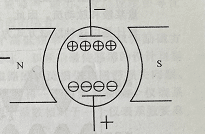The DC excitation mentioned here includes a constant magnetic field using a permanent magnet and a constant magnetic field excited by a DC current.
However, the DC signal voltage induced by the use of a DC magnetic field can easily polarize the electrolyte liquid flowing through the measuring tube, and the resultant signal obtained on the electrode is a composite signal composed of the polarization voltage and the signal voltage superimposed. It is difficult to separate the flow signal from the conversion amplifier for this kind of composite signal. At the same time, the polarization voltage is a function of temperature, and the signal drifts with temperature changes, causing instability of the measurement. Furthermore, the presence of DC voltage, as shown in Figure 3-4, will cause the positive ions of the electrolyte liquid in the measuring tube to move to the negative electrode, and the negative ions to move to the positive electrode. As time goes by, the layer of ions gathered at the electrodes continues to thicken, hindering the continued movement of conductive ions, forming a “cavity” with a low ion density in the middle, which causes the internal resistance between the electrodes to increase and affects the normality of the instrument work.

Because the conduction of liquid metal is electronic conduction, and under the action of the electric field formed by the induced DC voltage, the electrons in the liquid metal flow in one direction, there is no polarization problem of the electrolyte liquid, and there is no “cavity” phenomenon in the middle. On the contrary, if AC excitation is used, the liquid metal in the measuring tube will generate strong induced eddy current under the AC magnetic field, and cause the “skin effect”. This effect will not only increase the internal resistance of the sensor but also the induced eddy current will produce a stronger secondary magnetic flux. The secondary magnetic flux distorts the working magnetic field and causes distortion, which affects the normal measurement work. Using a DC magnetic field, the eddy current is almost zero, and the above-mentioned eddy current induction problem of the AC magnetic field does not exist.
This is the reason why the electromagnetic flowmeter with DC magnetic field is used to measure the liquid metal with high conductivity and cannot be electrolyzed, such as normal temperature mercury, high-temperature sodium, bismuth, and other conductive liquids.
The electric potential induced by a DC magnetic field is a DC voltage, which requires the use of a DC amplifier. Due to the large influence of temperature changes, it is more difficult to amplify and convert DC voltage signals than to amplify AC voltage signals. Therefore, the DC magnetic field is only used in the special liquid metal measurement occasions to use a strong hydromagnetic field, and the large signal that is induced does not need to be amplified, and the potentiometer can be directly used for measurement.
